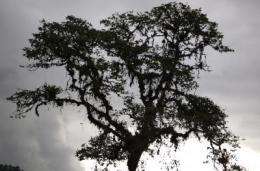Genetic differences influence the structure of communities

(PhysOrg.com) -- Scientists from The University of Manchester are among a group of researchers investigating how genetic differences among individuals contribute to the way ecological communities form, interact and change over time.
They say that understanding how individuals interact and form sustainable communities can help society to address issues including food security, prevention of disease and the coexistence between humans and nature in a crowded world.
Biologists from the Universities of Manchester, York, and St Andrews have edited a special issue of Philosophical Transactions of the Royal Society-B, which focuses on how genetic interactions between individuals shape communities of plants and animals.
'Community Genetics: at the cross-roads of ecology and evolutionary genetics' contains 13 research articles and commentaries by researchers, from the UK, the USA and Spain, examining how variation within species changes interactions among species.
The issue's co-editor, Dr Richard Preziosi, of the Faculty of Life Sciences in Manchester, said: "This research featured in this special issue of the journal reveals how genetic differences within species affect the wildlife communities of the whole local ecosystem."
Dr Preziosi's own research, which features in the special-issue journal, examined how the underlying genetic make-up of an individual tree can affect the community of associated species in a diverse and complex tropical rainforest ecosystem.
The Manchester team studied the plant and invertebrate communities that live on the Breadnut trees of the tropical forests of Belize in Central America to discover the extent to which an individual tree determines what species live on and around it.
"We found that more genetically similar trees were host to more similar communities of epiphytic plants, leaf litter invertebrates and trunk invertebrates," said Dr Preziosi. "The discovery was surprising given the diversity of the rainforest system and the numerous interactions between species that occur within it.
"Our work shows that there may be structuring within these ecosystems at the level of the trees, which has high biological significance in terms of rainforest conservation and restoration."
The team used ropes and harnesses to climb high into the forest canopy and count each orchid and bromeliad plant growing on 53 different Breadnut trees (Brosimum alicastrum). They also used pitfall traps, leaf litter collections and trunk traps to survey the invertebrates on each tree.
"In total, more than 2,100 individual plants were counted from 46 orchid and 17 bromeliad species, and 1,900 invertebrates from more than 80 species were also recorded," said Dr Sharon Zytynska, who carried out much of the work.
"The trees were all genotyped to tell us how genetically similar each one was to another and then the associated communities of each tree compared. The findings we observed suggest that a population of genetically similar trees would host a reduced diversity of plants and animals.
"This would have a knock-on effect for higher organisms too, such as the pollinators associated with the orchids or the amphibians that feed on the invertebrates, so have important implications for conservation efforts in these forests."
More information: rstb.royalsocietypublishing.or … unity-genetics.xhtml
Provided by University of Manchester


















